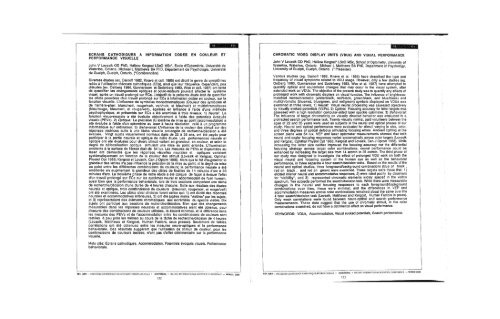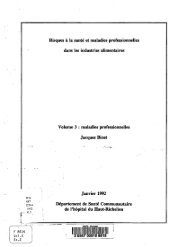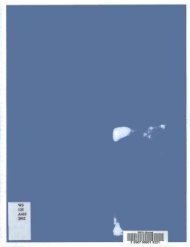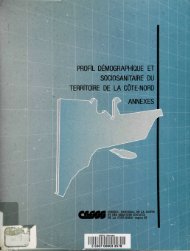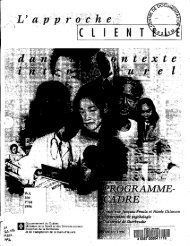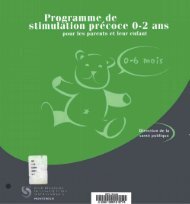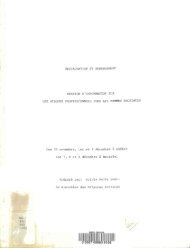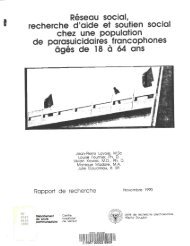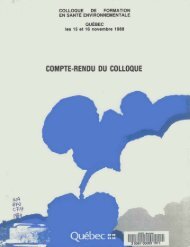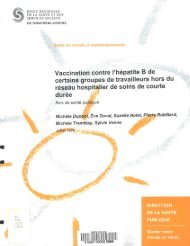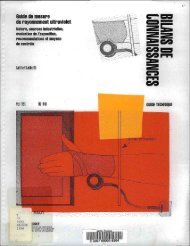le travail à l'écran de visualisation work with display units
le travail à l'écran de visualisation work with display units
le travail à l'écran de visualisation work with display units
Create successful ePaper yourself
Turn your PDF publications into a flip-book with our unique Google optimized e-Paper software.
ECRANS CATHODIQUES A INFORMATION CODEE EN COULEUR ETPERFORMANCE VISUELLEJohn V Lovasik OD PhD, Hélène Kergoat LScO MSc*, Eco<strong>le</strong> d'Optométrie, Université <strong>de</strong>Waterloo, Ontario. Michael L Matthews BA PhD, Département <strong>de</strong> Psychologie, Université<strong>de</strong> Guelph, Guelph, Ontario. (*Conférencière)Diverses étu<strong>de</strong>s (ex. Dainoff 1982, Knave et coll. 1985) ont décrit <strong>le</strong> genre <strong>de</strong> symptômesreliés <strong>à</strong> l'utilisation d'écrans cathodiques (ECs), ainsi que <strong>le</strong>ur fréquence. Cependant, peud'étu<strong>de</strong>s (ex. Ostberg 1980, Gunnarsson et So<strong>de</strong>rberg 1983, Woo et coll. 1987) ont tenté<strong>de</strong> quantifier <strong>le</strong>s changements optiques et oculo-moteurs pouvant affecter <strong>le</strong> systèmevisuel, après un <strong>travail</strong> prolongé sur ECs. L'objectif <strong>de</strong> la présente étu<strong>de</strong> était <strong>de</strong> quantifier<strong>le</strong>s effets possib<strong>le</strong>s d'un <strong>travail</strong> prolongé sur ECs <strong>à</strong> information codée en cou<strong>le</strong>ur, sur lafonction visuel<strong>le</strong>. L'influence <strong>de</strong> symbo<strong>le</strong>s monochromatiques (Cou<strong>le</strong>ur <strong>de</strong>s symbo<strong>le</strong>s et<strong>de</strong> l'arrière-plan: blanc/noir, rouge/noir, vert/noir, et b<strong>le</strong>u/noir) et multichromatiques(b<strong>le</strong>u/rouge, b<strong>le</strong>u/vert, et rouge/vert), égalisés en brillance <strong>à</strong> l'ai<strong>de</strong> d'une métho<strong>de</strong>psychophysique, et présentés sur ECs a été examinée <strong>à</strong> trois niveaux, 1) Neural: Lafonction visuo-neura<strong>le</strong> a été évaluée objectivement <strong>à</strong> l'ai<strong>de</strong> <strong>de</strong>s potentiels évoquésvisuels (PEVs). 2) Optique: La précision du système <strong>de</strong> mise au point (accommodation) aété évaluée <strong>à</strong> l'ai<strong>de</strong> d'un optomètre au laser <strong>à</strong> haute résolution relié <strong>à</strong> un programmeinformatique sur ordinateur. 3) Behavioral: L'influence <strong>de</strong> la cou<strong>le</strong>ur <strong>de</strong>s stimuli sur <strong>de</strong>sréponses motrices suite <strong>à</strong> une tâche visuel<strong>le</strong> prolongée <strong>de</strong> recherche/décision a étéévaluée. Vingt sujets visuel<strong>le</strong>ment normaux, âgés <strong>de</strong> 22 <strong>à</strong> 35 ans, ont été payés pourparticiper <strong>à</strong> la partie neuraie et optique <strong>de</strong> notre étu<strong>de</strong>. Les performances neura<strong>le</strong> etoptique ont été évaluées pour divers stimuli variant en gran<strong>de</strong>ur, en cou<strong>le</strong>ur, et selon <strong>le</strong><strong>de</strong>gré <strong>de</strong> défocalisation optique simulant une mise au point erronée. L'illuminationambiante <strong>à</strong> la surface <strong>de</strong> <strong>l'écran</strong> était <strong>de</strong> 54 lux. Les mesures <strong>de</strong> PEVs et d'optomètre aulaser ont démontré que <strong>le</strong>s réponses visuel<strong>le</strong>s neura<strong>le</strong>s et optiques variaientsystématiquement en fonction <strong>de</strong> la cou<strong>le</strong>ur <strong>de</strong>s stimuli (Lovasik et Kergoat, OphthalPhysiol Opt 1988; Kergoat et Lovasik, Can J Optom 1988). Alors que <strong>le</strong> fait d'augmenter lagran<strong>de</strong>ur <strong>de</strong>s <strong>le</strong>ttres n'a pas influencé la précision <strong>de</strong> la mise au point, ni <strong>le</strong> <strong>de</strong>gré <strong>de</strong> miseau point entre <strong>le</strong>s différentes combinaisons <strong>de</strong> cou<strong>le</strong>urs; la performance neura<strong>le</strong> a étéaméliorée en augmentant la gran<strong>de</strong>ur <strong>de</strong>s cib<strong>le</strong>s <strong>de</strong> fixation <strong>de</strong> 14 minutes d'arc <strong>à</strong> 28minutes d'arc. La troisième phase <strong>de</strong> notre étu<strong>de</strong> a été conçue <strong>de</strong> façon <strong>à</strong> évaluer l'effetd'un <strong>travail</strong> prolongé sur ECs sur <strong>le</strong>s systèmes neural et accommodatif <strong>de</strong> l'oeil humain,aussi bien que la performance behaviora<strong>le</strong>, lors <strong>de</strong> trois sessions comportant une tâche<strong>de</strong> recherche/décision d'une durée <strong>de</strong> 4 heures chacune. Suite aux résultats <strong>de</strong>s étu<strong>de</strong>sneura<strong>le</strong> et optique, trois combinaisons <strong>de</strong> cou<strong>le</strong>urs (b<strong>le</strong>u/noir, rouge/noir, et rouge/vert)ont été examinées. Les cib<strong>le</strong>s ainsi choisies furent cel<strong>le</strong>s qui: 1) ont élicité <strong>de</strong>s réponsesneura<strong>le</strong>s et accommodatives inférieures, 2) ont été jugées moins "visib<strong>le</strong>s" par <strong>le</strong>s sujets,et 3) représentaient <strong>de</strong>s éléments chromatiques aux extrémités du spectre visib<strong>le</strong>. Dixsujets ont participé aux sessions <strong>de</strong> recherche/décision. Bien que <strong>de</strong>s changementsmesurab<strong>le</strong>s dans <strong>le</strong>s réponses neura<strong>le</strong>s et accommodatives aient été obtenus, pourchacune <strong>de</strong>s combinaisons <strong>de</strong> cou<strong>le</strong>urs utilisées, ils étaient minimes, et la différence dans<strong>le</strong>s mesures <strong>de</strong>s PEVs et <strong>de</strong> l'accommodation entre <strong>le</strong>s combinaisons <strong>de</strong> cou<strong>le</strong>urs sontrestées <strong>à</strong> peu près <strong>le</strong>s mêmes au cours <strong>de</strong> la tâche <strong>de</strong> recherche/décision <strong>de</strong> 4 heures(Lovasik, Matthews et Kergoat, Human Factors, sous presse). Seu<strong>le</strong>ment <strong>de</strong> faib<strong>le</strong>scorrélations ont été obtenues entre <strong>le</strong>s mesures neuro-optiques et la performancebehaviora<strong>le</strong>. Ces résultats suggèrent que l'utilisation <strong>de</strong> stimuli <strong>de</strong> cou<strong>le</strong>ur, pour <strong>le</strong>scombinaisons <strong>de</strong> cou<strong>le</strong>urs testées, n'ont pas d'effet détrimentaire sur la performancevisuel<strong>le</strong>.CHROMATIC VIDEO DISPLAY UNITS (VDUs) AND VISUAL PERFORMANCEJohn V Lovasik OD PhD, Hélène Kergoat* LScO MSc, School of Optometry, University ofWaterloo, Waterloo, Ontario. Michael L Matthews BA PhD, Department of Psychology,University of Guelph, Guelph, Ontario. (* Presenter)Various studies (eg. Dainoff 1982, Knave et al. 1985) have <strong>de</strong>scribed the type andfrequency of visual symptoms related to VDU usage. However, only a few studies (eg.Ostberg 1980, Gunnarsson and So<strong>de</strong>rberg 1983, Woo et al. 1987) have attempted toquantify optical and oculomotor changes that may occur in the visual system, afterexten<strong>de</strong>d <strong>work</strong> on VDUs. The objective of the present study was to quantify any effects ofprolonged <strong>work</strong> <strong>with</strong> chromatic <strong>display</strong>s on visual function. The influence of brightnessmatchedmonochromatic (white/black, red/black, green/black, and blue/black) andmultichromatic (blue/red, blue/green, and red/green) symbols <strong>display</strong>ed on VDUs wasexamined at three <strong>le</strong>vels, 1) Neural: Visual neural processing was assessed objectivelyby visually evoked potentials (VEPs). 2) Optical: Focusing accuracy for <strong>le</strong>tter targets wasassessed <strong>with</strong> a high resolution computer-ai<strong>de</strong>d laser speck<strong>le</strong> optometer. 3) Behavioral:The influence of target chromaticity on visually directed behavior was evaluated in aprotracted search performance task. Twenty visually normal, paid volunteers between theages of 22 and 35 years were used as subjects in the neural and optical phases of ourstudy. Neural and optical performance were evaluated for stimuli varying in size, color,and three <strong>de</strong>grees of optical <strong>de</strong>focus simulating focusing errors. Ambient lighting at thescreen plane was 54 lux. VEP and laser optometer measurements showed that bothneural and ocular focusing responses varied systematically across color targets (Lovasikand Kergoat, Ophthal Physiol Opt 1988; Kergoat and Lovasik, Can J Optom 1988). Whi<strong>le</strong>increasing the <strong>le</strong>tter size neither improved the focusing accuracy nor the differentialfocusing strategy across target color combinations, neural performance could beenhanced by increasing the target size from 14 arcmin to 28 arcmin. The third phase ofour study was <strong>de</strong>signed to investigate the effect of prolonged VDU <strong>work</strong> on both thevisual neural and focusing system of the human eye as well as the behavioralperformance, in three separate 4 hour search/<strong>de</strong>cision tasks. Based on the results of theneural and optical studies, three foreground/background combinations (blue on black ,red on black, and red on green) were examined. These targets were those that: 1)elicited inferior neural and accommodative responses, 2) were rated poorly by observersfor "visibility", and 3) represented chromatic e<strong>le</strong>ments wi<strong>de</strong>ly spaced in the visib<strong>le</strong>spectrum. Ten subjects performed the search/<strong>de</strong>cision task. Whi<strong>le</strong> there were measurab<strong>le</strong>changes in the neural and focusing responses to each foreground/backgroundcombinations over time, these were minimal, and the differences in VEP andaccommodation measures across color combinations remained about the same over the4 hour search/<strong>de</strong>cision task (Lovasik, Matthews and Kergoat, Human Factors in press).Only weak correlations were found between neuro-optical and search performancemeasurements. These data suggest that the use of chromatic stimuli, in the colorcombinations examined, do not have a <strong>de</strong>trimental effect on visual performance.KEYWORDS: VDUs, Accommodation, Visual evoked potentials, Search performance.Mots clés: Ecrans cathodiques, Accommodation, Potentiels évoqués visuels, Performancebehaviora<strong>le</strong>.TEV 1989 — DEUXIÈME CONFÉRENCE SCIENTIFIQUE INTERNATIONALE • MONTRÉAL • SECOND INTERNATIONAL SCIENTIFIC CONFERENCE — WWDU 1989136TEV 1989 — DEUXIÈME CONFÉRENCE SCIENTIFIQUE IN TERNATIONALE • MONTRÉAL • SECOND INTERNATIONAL SCIENTIFIC CONFERENCE — WWDU 1989133


